Text
From the Potter’s Wheel – Series2 (Soup Bowls Set)

Known as one of the oldest and most beautiful forms of decoration, the tradition of pottery making dates back to the times of Indus Valley Civilization. Decorated pots have been used in all walks for a multitude of purposes. Pottery can be both handmade and wheel-made.
Figurines of religious importance, various artefacts, toys, dolls, pots, vases made of terracotta from Assam and Odisha; painted glazed pottery wares from Khurja in Uttar Pradesh; painted pottery with geometrical patterns from Bikaner and Pokhran in Rajasthan and Kagzi pottery from Alwar; and the famous blue pottery from Jaipur and works from states of Tamil Nadu, Himachal Pradesh and West Bengal are some of the worth mentioning names.
The Traditional Indian Pottery from Khurja
Khurja pottery is traditional Indian pottery work exclusively manufactured in the Khurja town of Bulandshahr district in Uttar Pradesh. Marked by colourful and useful products, Khurja pottery adds ethnicity and elegance to every home.
Characterized by the exotic hand painted floral patterns, in soothing shades of blue and brown, on an off-white base, Khurja pottery is known for its ancient beauty and charm. Besides shades of blue, green, and brown, these pottery items come in a range of warm colours like orange and red glazes, creating variety yet preserving the individuality of the art. Each piece is handcrafted to perfection with utmost care and precision. This pottery is known for its beautiful patterns and timeless appeal, making it a favourite among pottery enthusiasts and crockery collectors.
The collection of soup bowls, tea sets, vases, plates, and other cutlery items are available to make the dining experience extremely sophisticated. Khurja Pottery range is indeed worthy to be an indispensable part of every dining table thereby enhancing the beauty of every home.
The concept of wellness and eating right has led to a steep rise in the preference for soups and shorbas in almost every household today. Soups provide plenty of nutrients such as vitamins, minerals, and fibre while being low in calories and fat. Generally considered an easy-to-make dish that may help you pack a whole lot of nutrients into your diet, there are numerous recipes of soups that are tried and tested these days. And this had further led to the large scale sale and purchase of soup bowls these days. Earlier while people were conscious about their dinner sets, soup bowls have caught up tremendously in current times. Soup bowl sets have become an important part of tableware in the Indian fine dining. These are widely used in restaurants, buffets, households and hotels. It is a perfect match for Indian fine dining experience.
Carrying this concept forward, Craftghar brings to you a range of soup bowl set (in sets of 6 pieces with spoons) exclusively handcrafted from the skilled artisans of Khurja in Uttar Pradesh.

Blending ethnicity with modernity, this set of 6 soup bowl set with matching spoons is an absolute delight for every dining table. Exclusively handmade by our skilled craftsmen, these bowls are typical Khurja style with white base clay bowls adorning the beautiful traditional Warli art in black on them.
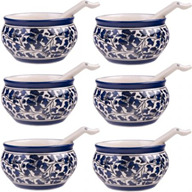
An extremely attractive glazed blue colour pottery from Khurja, this soup bowl set with swirling flowers and leaf motifs will certainly fetch you a number of compliments and admiring glances. Indeed an absolute delight for every dining place!

These soup bowls from Khurja is manufactured in typical Khurja pottery style. This time red colour paint is used instead of the regular blue colour. A must-have for every modern kitchen or dining space. The glamorous bowls will complement any home decor, and is perfect for serving soups and shorbas in regular use or for guests.
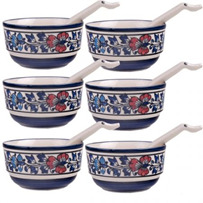
An extremely attractive glazed pottery from Khurja, with different colours used with blue paint, this soup bowl set with swirling flowers and leaf motifs is an absolute delight for every home. The matching spoons further add to the beauty of this 6 piece set.
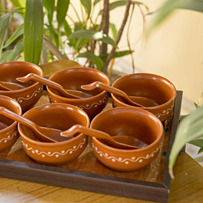
These mat brown soup bowls from Khurja are perfect for serving soups and shorba. This is well placed with a matching spoons. Well placed on your dining table, it shall look pretty stylish, neat, and modern adding a touch of elegance to your modern home and kitchen.

These exclusive Handmade and handcrafted Khurja Pottery Brown Ceramic floral motifs soup bowls. Serve your kids their favourite tomato or sweet corn soup in this 2 piece set made by our skilled artisans from Khurja.
Indian Handicrafts Online
0 notes
Text
From the Potter’s Wheel...
Known as one of the oldest and most beautiful forms of decoration, the tradition of pottery making dates back to the times of Indus Valley Civilization. Decorated pots have been used in all walks for a multitude of purposes. Pottery can be both handmade and wheel-made.
Figurines of religious importance, various artefacts, toys, dolls, pots, vases made of terracotta from Assam and Odisha; painted glazed pottery wares from Khurja in Uttar Pradesh; painted pottery with geometrical patterns from Bikaner and Pokhran in Rajasthan and Kagzi pottery from Alwar; and the famous blue pottery from Jaipur and works from states of Tamil Nadu, Himachal Pradesh and West Bengal are some of the worth mentioning names.
The Traditional Indian Craft
Khurja pottery is traditional Indian pottery work exclusively manufactured in the Khurja town of Bulandshahr district in Uttar Pradesh. Marked by colorful and useful products, Khurja pottery adds ethnicity and elegance to every home.
Characterized by the exotic handpainted floral patterns, in soothing shades of blue and brown, on an off-white base, Khurja pottery is known for its ancient beauty and charm. Besides shades of blue, green, and brown, these pottery items come in a range of warm colours like orange and red glazes, creating variety yet preserving the individuality of the art. Each piece is handcrafted to perfection with utmost care and precision. This pottery is known for its beautiful patterns and timeless appeal, making it a favourite among pottery enthusiasts and crockery collectors.
The collection of soup bowls, tea sets, vases, plates, and other cutlery items are available to make the dining experience extremely sophisticated. Khurja Pottery range is indeed worthy to be an indispensable part of every dining table thereby enhancing the beauty of every home.
Since time immemorial, Indian households have witnessed the use of pickle jars in large numbers. Indians have always been known for their spicy and delectable food accompanied by various pickles and Chutneys. The tradition continues to dominate our kitchens and dining spaces even today. Pickle sets are an important part of tableware in the Indian fine dining. For serving chutneys, pickles, vinegar onions to guests these give an authentic Indian dining experience. Pickle Set is widely used in restaurants, buffets, households and hotels. It is a perfect match for Indian fine dining experience.
Keeping this tradition alive, Craftghar brings to you a range of Pickle set (in sets of 2 and 3 pieces) exclusively handcrafted from the skilled artisans of Khurja in Uttar Pradesh.

A brilliant 3 piece pickle set with lids and spoons set in a matching tray from the hands of skilled craftsmen of Craftghar. This magnificent handmade pickle set is a must purchase-item for every pickle or sauces lover. Made with Khurja pottery in a white base and painted beautifully with the ancient Warli art promises to bring out the essence of traditional Indian handicraft.
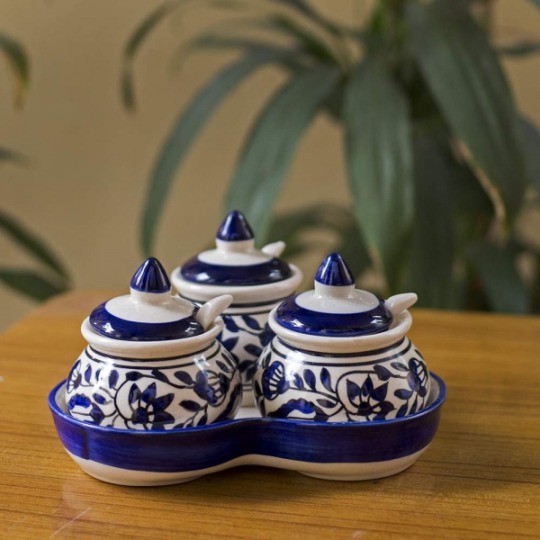
An extremely attractive glazed blue colour pottery from Khurja, this pickle set with swirling flowers and leaf motifs will certainly fetch you a number of compliments and admiring glances. The lids and spoons of these containers with a matching tray is an absolute delight for every dining place.
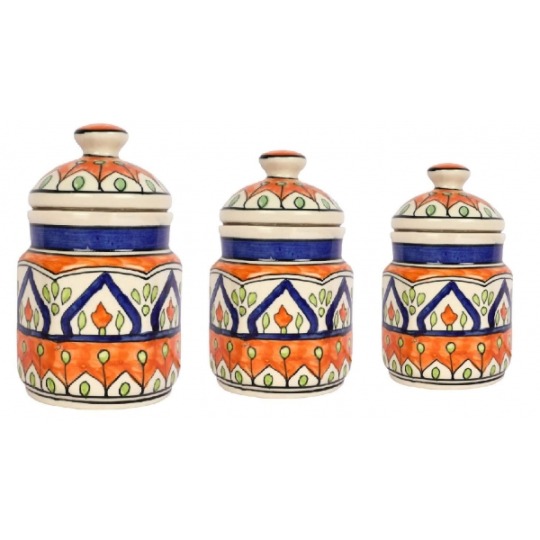
This beautifully attractive pickle set of 3 containers painted in Mughal style from Khurja. The typical white base pots and the vibrants colours brings the charm of the Mughal period to your dining table.
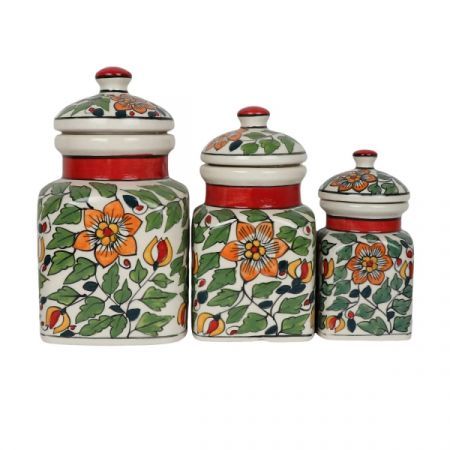
This multi-colour pickle set of 3 containers with matching lids in a floral motifs reminds of the beautiful work that is inspired from the Mughal Era.
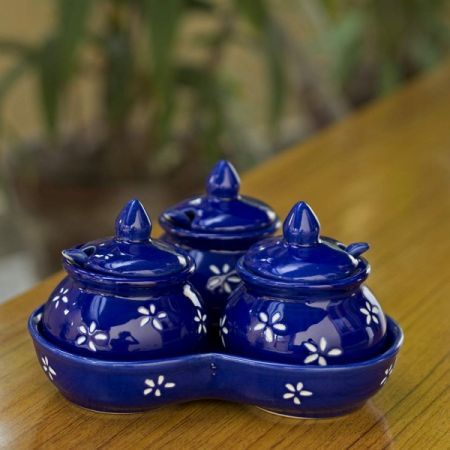
These Containers in blue glazed pottery is a must-have for every modern kitchen or dining space. The set comes with a nice tray where all three jars can sit, really an excellent piece of decor with actual utility. The glamorous blue pots will complement on any home decor, and is perfect for keeping seasonings storing condiments, sugar, pepper, salt, sauces and pickles, etc.
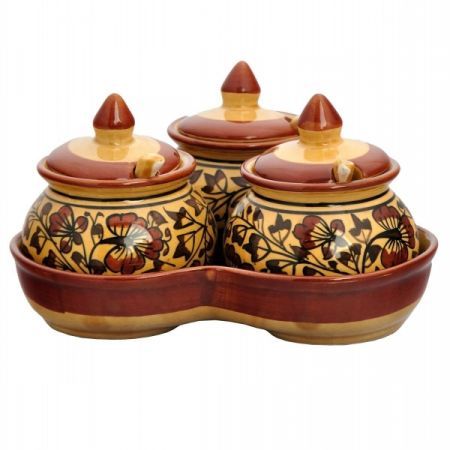
These exclusive Handmade and handcrafted Khurja Pottery Brown Ceramic floral motifs pickle serving and storage set. Use for serving pickles, sauces, salt, pepper etc, these 3 piece set is made by our skilled artisans from Khurja.
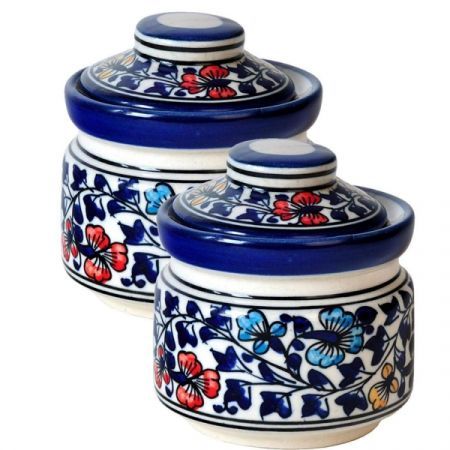
An extremely attractive glazed pottery from Khurja, with different colours used with blue paint, this pickle set with swirling flowers and leaf motifs is an absolute delight for every home. The matching lids further add to the beauty of this 2 piece set.
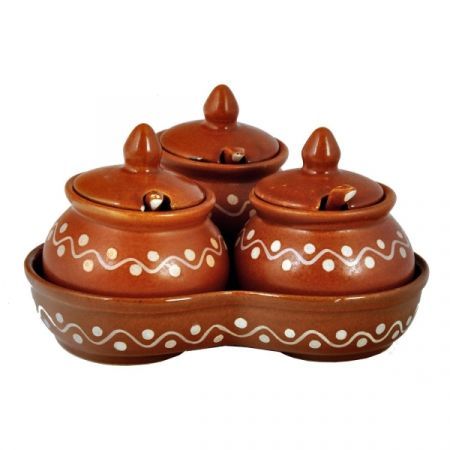
These mat brown pots from Khurja are perfect for serving pickles, sauces, etc. This is well placed in a matching tray and comes with lids and 3 different spoons for each pot. Well placed on your dining table, it shall look pretty stylish, neat, and modern adding a touch of elegance to your modern home and kitchen.
Indian Handicrafts Online
0 notes
Text
Papier Mache Craft

AESTHETIC APPEAL: PAPIER MACHE CRAFT FROM KASHMIR
We all are aware of Papier Mache as a craft piece that we made during our school activity class. But is Papier Mache just limited to junior school activity or is it beyond that? The answer is much more beyond…
Papier Mache is one of the most popular traditional crafts from Kashmir that has been passed down from generations for centuries. The art was introduced in India in the 14th century by a Persian mystic, Mir Syed Ali Hamdani on his visit to Kashmir. Several skilled artisans and craftsmen from Persia accompanied him who taught this beautiful paper art to the local craftsmen of the Valley. ‘Papier mache’ is actually a French word that means ‘chewed or mashed paper’. The art became famous by its Persian name ‘Kar-i-Qalamdani’ which means a pen case. Initially, it was restricted to making pen cases only. But through the years, as the local artisans from Kashmir learnt the art and added their own style to it thereby making it famous all over the world with a number of artefacts being manufactured under Papier mache.
The most famous papier mache artefacts include utility items like jewellery boxes, storage boxes, coasters, bowls, trays, pen stands and home decor items like vases, miniature hookahs, photo and mirror frames, Easter eggs, animal figures, wall hangings, etc. Papier mache is also used for making furniture pieces like stools, chests and cabinets, lamps, tables, etc. Some popular themes that are used in Kashmir Papier Mache include the designs inspired by life scenes of Mughal kings and queens, Gul Ander Gul (Flowers within flowers), Gul-i-Hazara (a pattern of thousand flowers), Bagaldar Chinar (the famous chinar tree of Kashmir), birds, Jungle scenes, and various geometrical patterns.
The art of making a Papier mache handicraft is very time consuming and requires a lot of dedication, accuracy and hard work. Papier Mache is carried out in two major steps -
SAKTHSAZI (MAKING THE STRUCTURE OF THE ARTEFACT)
The sakthsazi is the process in which the basic structure is made using the pulp of paper. It begins with soaking the waste paper in water for several days. This soaked paper along with pieces of cloth and the straws of a rice plant is then crushed manually in a stone mortar. The mixture is crushed until a very fine pulp is obtained. Glue is then mixed to this pulp.
This mixture is applied to the desired mould and then left to dry for some days. After drying, the piece along with the mould is cut into two halves and the mould is removed. The cut pieces are carefully joined together with glue. The structure is now smoothened with either a stone, baked clay or a wooden file.
NAQASHI (PAINTING OR DECORATING THE ARTEFACT)
A thin layer of butter paper is pasted over the smoothened piece which acts as a barrier between the basic raw structure and the final paint coat thereby protecting the paint from cracking off the finished article. The artist now draws different designs by hand on the object and it is coloured using minerals and organic or vegetable colours. Finally, the varnish is applied to give an added lustre to the artefact.
Besides making valuable Papier mache handicrafts, the art was used to decorate walls and ceiling of monuments like the Shah-e-Hamdan mosque and the Naqshband shrine in Kashmir.
Papier mache is a pure handcrafted and time-consuming art which is why the end products are generally expensive and rare. As a result, cheap, machine-made imitations of papier mache is flooded in the market leading to a decline in demand and sale of this traditional handicraft from Kashmir. To prevent this art from dying and to help the regional artisans earn a decent livelihood from it thereby protecting their knowledge and community rights, Geographical Indication (GI) tag is accorded to Kashmir Papier Mache in the year 2012.
Indian handicrafts online
2 notes
·
View notes
Text
Khurja Pottery
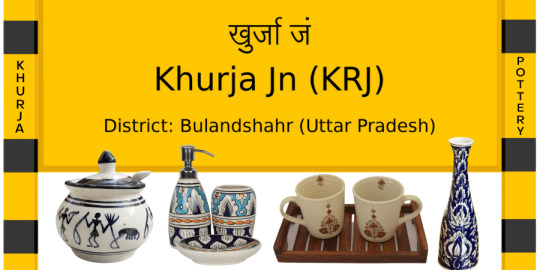
THE ALLURING KHURJA POTTERY
Many years ago, when I was doing my internship with a leading publication house in Delhi, I was commissioned to cover a pottery exhibition organized by a close friend of my publisher. I first thought it to be a promotional activity between two friends but that coverage proved to be much more than that. Besides, it impressed me to a large extent. That day, I realized that almost every second ceramic product that we all use in our household comes from Khurja. The exhibition was a means to promote the highly skilled artisans and the stunning art form from Khurja, a small town in the Bulandshahr district of U.P.
After taking some pictures of the colourful products, I decided to wait for some quotes from the organizer. As I sat quietly in a corner, I got a chance to converse with one of the potters, Ram Kumar, living in the bylanes of Khurja. As we chatted on the topic, he told me that the art of making this beautiful pottery is passed down from generations in his family. His forefathers descended from Multan (now in Pakistan) during the Mughal period and settled in Khurja. Ram Kumar felt proud as he narrated a well-known story that during the World War II in 1940, the British ordered the artisans of Khurja to manufacture few ceramic loo seats for their soldiers in the battlefield. They were so impressed by the craftsmanship of these artisans that the British decided to promote the pottery art and this small town of Khurja came to be known as the ceramic hub of India.
Khurja pottery has a satisfactory domestic demand, though the industry continues to thrive majorly on exports. These ceramic products range from daily utility items such as crockery, kitchen and bath accessories to home décor items like pots, vases, lamps and show pieces.
Ram Kumar proudly says, “My grandfather was very particular with his art. A slight mistake in any of the processes involved was a reason enough to make him angry.” He further added, “Making these ceramic wares is a complex process and if not done carefully, the products are prone to many errors. Then we need to discard these products. This means a loss of time, money and health. To craft a masterpiece, we need to give our complete attention and dedication.”
Among the most popular glazed pottery forms, Khurja pottery is a lead free pottery art and the process of making these ceramic wares is quite complex involving laborious tasks such as clay mixing, moulding, colouring, and finally glazing the coloured products in kilns.
Today, Khurja Pottery is not just limited to basic utility and decorative items only. Most of the pottery units in Khurja are involved in manufacturing HT/LT insulators, ceramic tiles, grinding balls, switches and electronic goods, sanitary ware, certain scientific goods, bone china crockery and chemical porcelain.
Modernization in the pottery industry has caused exports to rise and gain new heights. Countries like USA, UK, UAE, New Zealand, Australia, and Canada are the major export hubs for Khurja Pottery. Besides several initiatives being taken by the government of Uttar Pradesh, many designers and art connoisseurs are taking both professional and personal interests to renew the art by training these potters to meet the demands of modern consumers.
The growing interest of both domestic and international market in this timeless art has put a lot of pressure on the artisans to increase their production. This has led to a large scale imitation and production of cheap substitutes of this traditional pottery from Khurja. To preserve the uniqueness of this art form and the rights of Khurja Potters’, Geographical Indication certificate (GI tag) was awarded to Khurja Pottery in the year 2015.
Indian handicrafts online
0 notes
Text
Kantha Work

WEAVING A STORY: KANTHA EMBROIDERY
Every art form has a story to tell. But none can narrate better than Kantha Embroidery. Known since time immemorial, Kantha work is the best form of personal and artistic expression. What started as a hobby to utilize old and waste fabrics by the rural women of West Bengal became one of the most sought-after crafts of all times. From apparels like sarees, suits, dupattas, shawls, scarves, and skirts to home décor items like the cushion and pillow covers, bed sheets, curtains, tablecloths and mats, rugs, quilts, and blankets, Kantha work creates a perfect blend of the traditional and the contemporary.
The embroidery done on discarded clothes derives its name from the Sanskrit word ‘Kantha’ which means ‘rags’. ‘Kantha’ also means ‘throat’ and thus the embroidery done in earlier times began by telling the mythological tale of Lord Shiva (NeelKanth) consuming poison.
The gorgeous Kantha embroidery involves the simple running stitches done mostly on the cotton and silk fabric with beautiful and colourful motifs of flowers, animals, birds, and basic geometrical shapes. Over time, more elaborate patterns from mythology, folklore, and everyday life scenes developed, which came to be known as ‘Nakshi Kantha’ after the Bengali word ‘naksha,’ which means artistic patterns. The entire piece of fabric is covered with multiple lines of straight, running stitches giving a slightly wrinkled and wavy effect to the cloth. To cater to the modern demands, Kantha embroidery has expanded its reach beyond cotton and silk fabric and is now done on different fabrics like Crepe, Georgette, and Chiffon as well.
Based on the use of the fabric, Kantha is divided into seven different types:
LEP KANTHA
This type of embroidery is done on a number of sari layers, placed on top of each other to be used as a quilt during winters. Simple geometrical designs are made with straight running stitches using coloured threads.
SUJANI KANTHA
This is the most popular and beautiful Kantha. Mostly done on blankets or clothes used for special functions and weddings, sujani Kantha has diverse patterns like the lotus flower, scenes from Ramayana, Mahabharata, folktales, dancing girls, men riding on horseback, birds, animals, bees, a procession in motion, etc. A border with geometrical patterns at both ends of the fabric is a major characteristic of sujani kantha.
BAITON KANTHA
This embroidery is done on the fabrics that are used to cover books and other valuables. The motifs of lotus, pots, conch shells, trees, plants, flowers, birds, elephants, chariot, human and divine figures are generally made using red, yellow, green, and blue coloured threads. It is elaborately patterned with borders of colourful designs. This kantha is often carried while traveling and is presented as gifts to family and friends.
OAAR KANTHA
In this type simple designs with decorative borders are done. They are generally found on pillow and cushion covers. Simple designs like trees, plants, creepers, birds with a decorative border are made around its four sides.
ARSHILATA KANTHA
Arshilata is used as a cover for mirrors, comb, and other toilet accessories. It has a wide border and the central motif is depicted from the scenes of Krishna Leela or Radha-Krishna Raas. The lotus flower, trees, creepers, spirals, inverted triangles, zig-zag lines are some of the other used motifs.
DURJANI/THALIA KANTHA
It is a square piece kantha that is used to cover the wallet. It has a lotus motif in the center with an elaborate border at the sides.
RUMAL KANTHA
This is the smallest among all the kanthas. Like most of the other kanthas, lotus remains the main theme of this embroidery. At times motifs of plants and animals are also embroidered.
This exquisite art of Kantha is passed down through generations and is mostly practiced by the women of West Bengal wherein the intricate stitches are woven using just a needle and thread on the fabric. The flourishing art saw a decline after the partition of India and Pakistan when most of the Bengali artisans migrated to Bangladesh (then East Pakistan). But in recent times, with the efforts of many art connoisseurs, Kantha embroidery is revived and resurrected. To prevent the imitation of this precious embroidery and to preserve the rights of women workers for whom this art has been a major source of living for decades, Nakshi Kantha is awarded Geographical Indication (G.I.) tag in the year 2008.
Indian handicatfts online
1 note
·
View note
Text
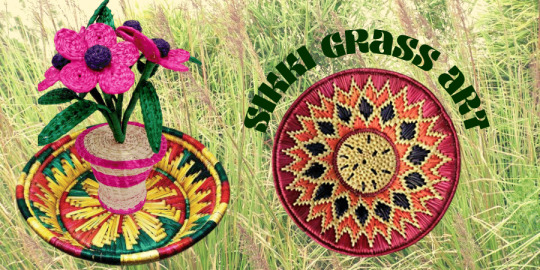
THE GRASS ART
The tableau of Bihar on the theme of ‘Sikki Grass Craft’ during the Republic Day Parade, 2013 in New Delhi. The subsequent year saw the Bihar Pavilion at Pragati Maidan in New Delhi being decorated with Sikki Art during the International Trade Fair, 2014. Both these managed to bring back the disappearing traditional Craft form from Bihar and the incredible products made under it in the eyes of the world.
Sikki work was believed to be one of the must learn the craft for the young girls of marriageable age in Bihar. The items crafted by her used to be an important part of her dowry. Gifting various handcrafted products using sikki grass was a ritual followed in Bihar at the time of marriages.
Sikki grass grows in the waterlogged areas during the months of August and September. The grass is first removed from the stalks and is dried in sun for several days. Later, it is boiled in hot coloured water to add softness, flexibility and colour which makes it easier to be shaped into different objects like lamps, baskets, pots, stools, boxes and other decorative articles.
The technique used for making Sikki products is the simple coiling method. The actual shape of the object is formed with munj or khar (cheaper variants of grass available in the area). This forms the base of the product and gives it additional strength. Sikki grass is then coiled over a base made with munj thereby completely covering the structure. The only tool required in this art is a needle-shaped object called takua with which coiling and weaving are done. The natural sikki grass has a beautiful golden colour which is why it is also called Golden Grass. It is later coloured into different shades like red, yellow, green, blue, purple, and pink, etc. This coiling and weaving of coloured grass with the natural golden grass give a distinctive and unique appeal to the Sikki craftwork.
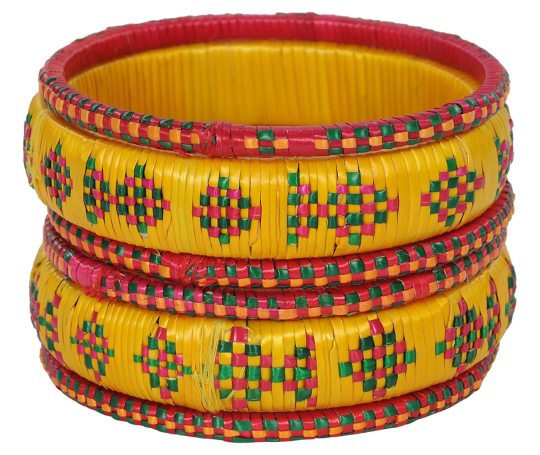
Sikki grass products are light in weight, organic, biodegradable and long-lasting. Earlier, women used to make utilitarian products like different kinds of baskets and boxes which were locally known as Jhappa, Mauni, Pauti, Gumla, Saji.
Jhappa - Big containers with covers to store food grains, spices, sweets, etc.
Mauni - Trays for keeping fresh fruits, betel leaves, nuts, flowers, etc.
Pauti - Beautiful small boxes with covers to keep jewellery, dry fruits, and other expensive items.
Gumla - Bowl like containers that served multiple uses.
Saji - Flower baskets.
Apart from these, there are also decorative and useful pieces made out of sikki grass such as coasters, mobile covers, masks, mirror frames, table mats, pencil boxes, hand-held fans, colourful bowls, jewellery boxes, bangles, toys, pen stands, paperweights, jewellery pieces, figures of deities and even dresses.
The main centres for Sikki art are located around Rayam, Rampur, Madehpur, Siddhi, Jaynagar, Katihar, Gaonaha, Sonvarsha and Sitamarhi in Bihar. With the advent of cheap plastic goods, the demand for traditional Sikki craft objects started declining. However, the art saw a revival in recent times as the awareness of the harmful effects of plastics came to light. With the efforts of Upendra Maharathi Shilp Anusandhan Sansthan in Patna, many artists trained themselves with the new skills and designs to meet the modern requirements. Furthermore, several award-winning artists like Kumudani Devi, Dhirendra Kumar, Najda Khatoon, Meera Thakur among others are working hard to keep this ancient craft form alive.
To preserve the traditional craft against imitation and the rights of artisans practising Sikki grass work in Bihar, it was registered under Geographical Indication (G.I. Tag) in the year 2007.
So, in case you are bored with your current home décor and are looking for an alternate means to redecorate your home, opt for this natural and eco-friendly product – Sikki Grass…
Indian handicrafts online
0 notes
Text
Incredibly Inlaid
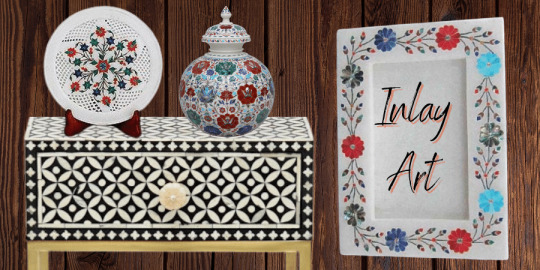
THE INCREDIBLE INLAY ART
Beauty lies in the eyes of the beholder… But this common adage isn’t true in the case of inlay art. This indigenous art form is capable of leaving everyone spellbound at the first look. Taj Mahal, one of the Seven Wonders of the World is a perfect example of marble inlay art.
The beautiful art supposedly developed around the 16th century in Italy as Pietra Dura and was brought to India by the Mughal Emperor Akbar. Known as Parchin Kari, it is a technique of inlaying semi-precious stones such as jade, onyx, turquoise, mother of pearl, etc. in marble, wood, ivory, and even metals.
In this article, I will talk about two of the most precious and lavish forms of Inlay art – Marble Inlay and Bone Inlay.
MARBLE INLAY
This is the most ancient form of Inlay art practiced exclusively in Agra, Uttar Pradesh, and some areas of Rajasthan. Most of the works of architecture from the Mughal Era are designed in marble and bear this extravagant art form on their walls and floors. The intricate details of the pattern are filled beautifully with colourful stones. Besides thin slices of marble, the grooves carved on marble are filled with precious or semi-precious stones like onyx, jasper, carnelian, opal, jade, turquoise, etc. The love and attraction among people for the intricate and mesmerizing monuments from medieval times forced the artisans to replicate this beautiful art on various utility and home décor products. The never-ending list of marble inlay work includes flower vases, fruit bowls, marble inlay tiles, pen and candle stands, photo frames, wall hanging plates, trays, tables, jewellery boxes, figurines of animals and divinity, coasters, chess boards, etc.
THE PROCESS INVOLVED
The Marble is first to cut into the desired shape according to the decorative item to be made. Tabletops, coasters, plates, ashtray, flower vases, trinket boxes are some of the popular artifacts made in marble.
A design of either geometrical patterns or floral motifs is drawn on a brass sheet and transferred onto the marble. The carving tools called ‘tankiya’ and ‘narzi’ are used to engrave the pattern by creating grooves on the surface of the marble.
The semi-precious stones are selected on the basis of design i.e. flowers, leaves, animals, birds, etc., and are shaped using a hand-operated machine called Emery wheel.
The colourful stones are then stuck in the grooves on marble using traditional glue and left to dry. After it is dried completely, the inlaid marble surface and the edges are smoothened using fine sandpaper. It is finally polished and a remarkable piece ready for use.
BONE INLAY
Another art form that has transcended medieval times with evidence of embellished furniture from the Mughal and Rajput eras is the magnificent Bone Inlay art.
Bone inlay is the ornamental technique that involves inserting delicate, hand-carved pieces of bone or mother of pearl into the surface of an object. The patterns followed are generally floral and geometric. The sophisticated and timeless art of bone inlay is passed from one generation to the next and is practiced exclusively in the Jodhpur, Udaipur, and Jaipur regions of Rajasthan.
Bone inlay is a spectacular art with beautiful and unique patterns carved on various pieces of furniture and no two pieces designed by the skilled craftsmen are the same. The luxurious furniture crafted under this art lends an exotic appeal to a simple room and can never go unnoticed by anyone. Whether it is a cabinet, chest, table, chair, stool, bed, photo frame, cupboard, or even mirror, this intriguing Indian art in all its form is praised and exported to several places across the world.
THE PROCESS INVOLVED
Firstly, a pattern is carved out from the material. This material can be either mother of pearl or cruelty-free polished bone from camels that have died of natural causes. Then depending on the utility item that needs to be crafted, the base object is chosen. This can be either wood, metal, or ivory. The designs are carved on these to match the prepared design so that the delicate pieces of bone or mother of pearl can be neatly fit onto the surface. After this, the resin in contrasting colours is filled around the bone shapes giving the final touch to a magnificent piece of furniture.
CARING AN INLAY ARTIFACT
Since Inlay art is done using sensitive materials like marble, semi-precious stones, bones, and mother of pearl, dust the objects regularly with a dry soft cloth only for a long-lasting shine. The use of harsh chemicals must be avoided on surfaces. In case of spills or leaks, objects must be immediately cleaned with a mild cleanser using a soft cloth to avoid stains. Heavy and sharp pointed objects should not be brought in contact with these objects. Always handle these delicate artifacts with extreme care to avoid any sort of breakage.
Indian handicrafts online
#Inlay art#inlay artefact#marble art#marble inlay#bone inlay#mother of pearl#semi precious stones#agra#jaipur#pietra dura#parchin kari
0 notes
Text
Block Prints of Sanganer & Bagru
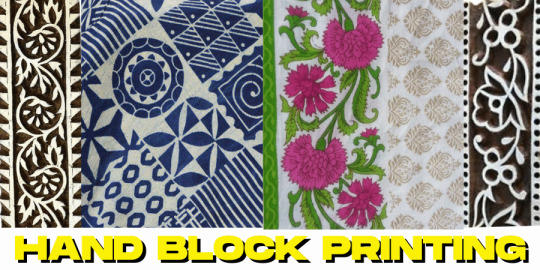
BUILDING BLOCKS
One of the most colourful and vibrant states of India, Rajasthan is famous for its rich heritage and cultural background. The rich tradition of Rajasthan is attributed to the influence of majestic Rajputana culture and a number of communities here who are involved in performing some exclusive art and craft activities for decades. In this blog, I will talk about one of the most talented communities and its special art form – the Chhipa community and their very famous Hand Block printing.
The art of Hand Block printing started in Sanganer, a town near Jaipur around the 18th century during the reign of Maharaja Sawai Jai Singh. The constant availability of water near the town and the royal patronage helped the hand block printing industry to flourish fast. Initially started as a local craft done on clothing fabrics in the small town of Sanganer, it later spread to other places like Bagru, Ahmedabad and Farukhabad. It was passed down from one generation to the other as one of the foremost fabric printing techniques for both fashion and furnishing industries.
This art of printing requires skilled craftsmen to create a uniform, clear and accurate patterns on the cloth. The design to be printed is first drawn on paper and then transferred to a smoothened wooden block. Then follows the process of the fine carving of the pattern on the block. The block is then soaked in oil so that it gets soft to give a good impression on the fabric when dipped in the dye for final printing. The dyes used in block printing can be either natural or synthetic depending on the requirement. This printing draws its inspiration from nature and mythology where traditional Indian motifs of flowers, fruits, birds, animals and human figures were drawn.
Though Block printing was started in Sanganer, it soon spread to Bagru, a small village near Jaipur. This gave rise to two beautifully different hand block printing styles – Sanganer Block Printing and Bagru Block Printing.
SANGANER BLOCK PRINTING
Sanganer block print is the most famous printing style and is primarily done on an off-white or white coloured fabric with neatly crafted and intricately detailed wooden blocks. The printing is dominated by floral and geometric patterns using both natural and chemical dyes. It is also known as Calico printing. Here, the outlines are first printed, and then the colour is filled in it. The patterns are printed repeatedly in diagonal rows. Today, Calico printed bed covers, quilts, saris, etc. are much in demand.
BAGRU BLOCK PRINTING
This printing technique is generally done on the bluish indigo background using natural colours. Bagru is famous for its Syahi-Begar prints and Dabu prints. In Syahi-Begar prints, designs are in the combination of black and yellow ochre or cream while in Dabu prints, a part of the pattern is hidden from the dye by applying a resist paste. The motifs in the traditional Bagru printing are geometrical patterns combined with flowers, leaves and other life forms.
Hand block printing has always been one of the most admired arts and has successfully survived for ages. Besides having a tremendous demand in the apparel industry for saris, suits, tops, and dresses, it caters to the accessory segment as well where handbags, clutches, and even jewellery pieces have hand block motifs. This technique of block printing is used in both fashion and interior industry wherein products of home décor like bed sheets, bed covers, pillow and cushion covers, table cloths, curtains, etc. are becoming extremely popular.
The tremendous efforts that go into each stage of the block printing process make the art truly worthy of every bit of recognition and appreciation it enjoys all over the world. The Geographical Indication certificate (GI tag) awarded to both Sanganer block print and Bagru Block print in the years 2010 and 2011 respectively have not only recognised the uniqueness and beauty of the art form but has also given a distinct identity to its extremely talented Chhipa community.
HOW TO CARE FOR HAND BLOCK PRINTED FABRICS
These fabrics are delicate and can be machine-washed with a mild detergent in cold water. It is preferable to wash colours separately. Pre-soaking of fabrics should be avoided and they should be dried in shade away from direct sunlight. The block printed fabrics should be ironed on the reverse side of printing.
Indian Handicrafts Online
#block printing#block print#chhipa community#bagru block print#hand block printing#syahi-begar#dabu#sanganer block print
0 notes
Text
Glass Paintings
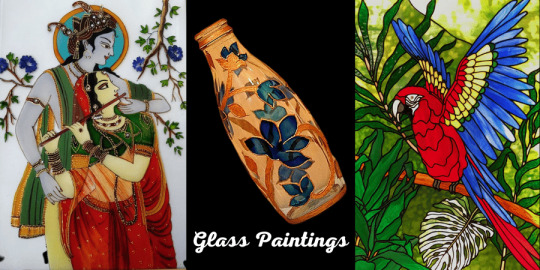
GLASS PAINTINGS
I had my first encounter with colourful glass art when I visited Paris many years ago. Home to some of the most beautiful cathedrals in the world, Paris combines the magnificence of their architecture with the grace and vivacity of their windows. I was so amazed by the beauty of these stained glasses that depicted the scenes from the Bible, that on my return back home, I started my extensive research on the topic.
One of the oldest art forms, glass paintings were prominently seen in the 10th century in Europe when the art was exclusively portrayed on most of the church windows where small pieces of glass were stain painted and transformed into the Mosaic form of art. Later, at the time of the Renaissance in Venice glass painting was largely practiced and sooner it flourished all over Europe. With the passage of time, these glass paintings came out of churches and found their way into the homes of people. They were adopted, modified, altered, and influenced by different cultures across the world.
Glass painting came to India in around the 18th century when Chinese traders settled in Gujarat and brought this beautiful art with them. Within no time, the Indian artists started experimenting and implementing this colourful art in their work. Reflecting symbolic and cultural aspects, mythological figures started to dominate the Indian glass paintings. Characterized by their bright colours and ornamental nature, glass paintings were even embellished with gold thread and semi-precious stones. However, with changing times, glass paintings evolved their theme from Biblical and Mythological characters and gave complete freedom to the painter to portray any subject of his choice on the glass. From floral patterns, landscapes, portraits to the images of birds and animals, the modern glass paintings were slowly influenced by abstract art as well. Contemporary glass painting artists are converting three-dimensional objects like wine glasses, crockery, and other items into beautiful, decorative objects with different designs.
The process involved in a glass painting is not difficult to understand. A sketch is first drawn on a sheet of glass. Using an outliner, the image stands out. And finally, colours are filled in the image. Generally, acrylic enamel, acrylics marked suitable for glass, and specially formulated solvent-based paints are used for glass paintings. A proper design, appropriate paints, thin brushes combined with minute craftsmanship are the basic ingredients to make an exquisitely attractive piece of glass painting.
GLASS PAINTINGS GENERALLY FALL INTO TWO CATEGORIES:
STAINED GLASS PAINTING
This is an older form of glass painting where pieces of glass were stained in metallic salts and then brought together to form a picture and each glass piece is fixed with lead strips on another glass for support. Stained glass paintings are usually seen on the window and tabletop glasses.
REVERSE GLASS PAINTING
In this type, the painting is done on the reverse side of the glass. This technique is a relatively newer form of glass art giving a neater and a uniform look to the painting. This technique is usually used for making glass wall hangings and clocks.
Different effects of paintings on the glass
OPAQUE LOOK
Generally used for freehand paintings, this is suitable for giving a solid colour effect to the glass.
TRANSPARENT COLOUR
It is generally used to impart a translucent or a see-through effect to the glass.
THREE DIMENSIONAL
This effect gives a raised appearance to the image using thick glass paint with fine tips on the bottle so as to draw a 3-dimensional design.
STAIN AND FILLED COLOUR
This is used to fill colour in the image. These paints are much thinner and more free-flowing than other paints. They generally give a wash-over effect to the painting.
SPECIALTY FINISHES
A specialty glass paint adds shimmer and sparkle to the glass.
Indian handicrafts online
#glass art#stained glass#glass paintings#enamel paints#stained glass paintings#reverse glass painting#acrylic enamel
0 notes
Text
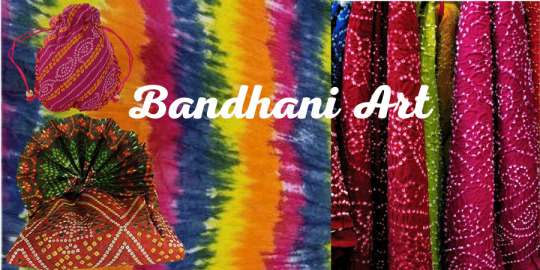
THE COVETED BANDHINI ART
What comes to your mind when the states of Rajasthan and Gujarat are mentioned? The vast stretches of Thar Desert… The mighty Aravali range… Sabarmati River flowing peacefully… Majestic forts and palaces… The energetic dandiya raas… Sumptuous vegetarian thalis… And the vivacious Bandhani or Bandhej sari.
The word ‘Bandhani’ comes from the Sanskrit word ‘Bandhan’ which means ‘to tie’. It is the traditional Indian ‘tie and dye‘ art (resist-dyeing technique) that results in colourful and interesting patterns on the cloth. The first Bandhani sari was perhaps worn at the time of Bana Bhatt`s Harshacharita for the occasion of a royal wedding. The patterns of this art form were also seen in the 6th century paintings in Ajanta. Bandhani work was started by the Khatri community of Gujarat. The major cities in Rajasthan like Jaipur, Sikar, Bhilwara, Udaipur, Bikaner, Ajmer, and Jamnagar in Gujarat are well known producers of Bandhej saris, dupattas, odhnis and pagdis.
Earlier, dyes were extracted from natural plant sources like roots, flowers, leaves, and fruits. But today, besides these natural dyes, easy to use and permanent synthetic colours are also used in tying and dyeing process.
The process involved in this art is completely design oriented. The fabric to be tied and dyed is cleaned thoroughly and then bleached. Bleaching ensures that the fabric is free from any residual colour and picks the new colour instantly. After the cloth is dried, a very small portion of the material is raised and tied into knots using a cotton thread. The knotted material is then dyed in a light colour. The knotted parts retain the original colour, and the rest of the fabric gets dyed. Then these lighter dyed portions are knotted, and the material is soaked again in another dye. This process is repeated for different colours.
Elaborate motifs and designs like flowers, jaals, bells and creepers are made using this tie and dye technique. The knots are placed in clusters each having a different name:
• Ekdali: single dot
• Tikunthi: three dots that make circles and squares
• Chaubundi: four dots
• Satbandi: dots in groups of seven
• Boond: small dot with a dark center
• Kodi: tear or drop-shaped pattern
• Dungar Shahi or Shikargah: a mountain-like pattern
• Jaaldar: web-like pattern
• Beldaar: vine-like pattern
• Laddu Jalebi: swirling pattern
• Leheriya: wave-like pattern
DIFFERENT TYPES OF BANDHANI SARIS:
GHARCHOLA
The most popular and finest of Bandhani from Gujarat is the Gharchola. Golden threads are woven into the fabric that needs to be used for tie and dye. Considered auspicious, gharcholas are exclusively designed for brides making it the most important addition to her wedding trousseau. Gharcholas were earlier made with cotton fabric but with changing times, silk has successfully taken over the humble cotton. They are mostly designed in bright colours like orange, red and green.
AMBADAAL
Another common pattern seen in bandhej is the Ambadaal or the mango branch wherein the fabric is designed entirely in a jaal-like pattern.
BAVANBAGH
Bavanbagh means 52 gardens wherein the fabric is designed in 52 segments each with a small bandhani pattern.
RASMANDALAS
It is a circular pattern showcasing the rasleela or the dancing gopis, done intricately using a tie and dye method.
CHANDROKHANI
The word chandrokhani means figures of moon. An attire for a newlywed bride, this bandhej sari in dark base and circular moon pattern symbolizes a comparison between the moon and the bride.
Over the years bandhej patterns and garments have evolved tremendously. Earlier only saris, dupattas and traditional clothing were made using this method. But to meet the modern demands, items of home décor like pillow and cushion covers, napkins, tablecloths, bed sheets, etc are also made with this technique. Recognising the exclusive tie and dye bandhani art, Jamnagari bandhej was included in the Geographical Indication (G.I.) registry in the year 2016.
Indian handicrafts online
#Bandhini#bandhej#bandhini sari#bandhej sari#gharchola#tie and dye#resist dyeing#ambadaal#bavanbagh#rasmandala#chandrokhani
0 notes
Text
Splash of Colours

COLOUR PALETTE
The moment we hear the word ‘Rangoli’, an image of extremely colourful and vibrant patterns decorated on the floors to celebrate an occasion or festivity conjures our mind. Reflecting ethnicity, folklore and traditions of different areas, Rangoli is an expression of gratitude towards Nature and a perfect symbol of beauty, hope, and culture.
The word Rangoli comes from a Sanskrit word ‘rangavali’ which means rows of colours or coloured earth. Rangoli is traditional Indian folk art, generally created on a floor on special occasions. The origin of rangoli making can be traced back to the Hindu mythological Puranas when it was practised as a part of the daily ritual by women to decorate their houses so as to ward off evil spirits and bring good luck. This divine art is seen as a means of decorating homes to bring peace, health, prosperity and good luck to the lives of the people living in. In earlier times, women used to chant hymns and bhajans while making rangolis. It is believed that a rangoli drawn on the floor has a calming effect on the minds of guests coming to the house. It generates positive vibrations in their mind, thereby making them feel invited and comfortable in the new environ.
The designs of rangolis are believed to have psychic aspects. Each design is believed to have a spiritual angle. The energy created by the patterns of rangoli motivates and generate positive energy in people. A rangoli should be completely balanced with one side exactly similar to the other. The sharp edges of Rangoli represent luck, growth, and prosperity. The centre of Rangoli is generally in circular form symbolizing ‘garbha’ i.e. the main chamber of a temple. The dots drawn in most of the rangoli patterns can be related to tilak on the forehead.
The tradition of Rangoli making on the floor started in Maharashtra and it slowly spread to other parts of India. In Tamil Nadu, Rangoli is known as Kolam. In Rajasthan, the Mandanas are drawn on walls. In Kolkata, Alpana is drawn in the courtyard. Chowkpurana in Uttar Pradesh, Aripana in Bihar and Muggu in Andhra Pradesh.
Rangolis are meticulously painted using both wet and dry colours. Rice powder or paste, coloured rice grains, chalk powder, flour, sand and flower petals are used to make outlines of the design. The design is then filled with colours from natural substances like vermillion, turmeric powder, indigo powder, flowers, flower petals, coloured sawdust, sand and even ground pulses.
Rangoli can be made on the floor, sidewalk, or entrance of homes. Firstly a smooth and even surface is selected to draw a pattern. The area is washed or wiped with water and left to dry. The basic outline of the Rangoli is drawn with chalk, crayon or a pencil and then topped with rice powder or flour so that the outline stands out clearly. The pattern is then filled with different colours to bring out the sharpness and details in the most effective manner.
The designs of rangoli can be simple geometric patterns, floral shapes or can even have very intricate designs. Some common patterns used in Rangoli are pictures of peacocks, parrots, swans, diyas, lotus flowers, mangoes, fish, leaves etc.
In the past, most of the rangolis made in the states of North India were made square in shape while they were hexagonal in South India. The rangolis made at the festival of Onam in Kerala used to be circular in shape. But today, though a slight resemblance might be present to these ancestral designs, rangoli patterns are not region-specific anymore.
Types of Rangolis:
Rangoli making is of two types on the basis of patterns:
Form
The geometric shapes of circles, cones and lines are form-dominant type of rangoli.
Ornamental
Ornamental rangoli includes the images of birds, animals, trees, flower and deities. They might have a conch, Swastika, moon or sun in the centre. Each pattern is believed to have a religious connotation. The eight petals of lotus are a symbolic representation of the Sun, Lord Vishnu and eight directions of the Universe. The lotus represents Goddess Lakshmi and is considered to be a symbol of procreation whereas her feet represents wealth and prosperity. Similarly a diya drawn in a rangoli is a symbol of enlightenment, knowledge and wisdom.
Indian handicrafts online
0 notes
Text
The magnetic Pochampally Ikat

PRICELESS POCHAMPALLY
Mesmerizing and intricate geometrical patterns spread all over the fabric. Extremely lightweight and comfortable to wear. The rich lustrous look and royal feel perfect for various occasions…. I am talking of none other than Pochampally Ikat.
The art of making Pochampally sari or Pochampally Ikat goes back to the 1950s from Bhoodan Pochampally, a small town in Telangana. Popularly known as the ‘Silk City of India’, Bhoodan Pachampally is accredited to making beautiful heirlooms that can be passed from one generation to the next.
Pochampally Ikat or resist-dyeing involves the process of tying and dyeing the sections of yarn to a fixed colour pattern before weaving. The dye penetrates into the exposed section, while the tied section remains un-dyed. The patterns formed by this process on the yarn are then woven into the fabric. Ikats are basically of two types viz. ‘Single ikat’ and ‘Double ikat’. In Single ikat, only the warp is tie-dyed and interwoven with the weft, which can be either in single or no colour. In double ikat, both, the warp and the weft go through a resist dyeing procedure. After which, they are woven into a single cloth. Pochampally Ikat generally uses the double Ikat method of transferring intricate patterns onto the fabric. This is perhaps the most difficult and expensive type of weaving process. The artisans take around 10 to 20 days for weaving simple patterns onto a single sari while the complex and more intricate designs take months to be woven.
Initially, Pochampally Ikat saris were only woven in cotton fabrics, but later silk became the most popular choice of fabric. Pochampally silk saris are lightweight and extremely comfortable to wear. The rich look and light feel make this beautiful sari an obvious choice for both casual and formal occasions. Traditionally, the famous Pochampally Ikats came with geometric patterns only. But recently, the addition of intricate motifs of elephants, parrots, dancing girls, flowers, leaves, and paisleys have beautifully combined within the geometric grid, giving a mesmerizing look and feel to the Pochampally sari.
Pochampally is a traditional art that has always been encouraged for its exclusively imaginative designs and the exquisite craftsmanship in the weave. Apart from making saris, Pochampally Ikat is also used to create dress material for making stoles, scarves, kurtas, tops and home décor, which includes bed sheets, cushion covers, carpets, table linen, etc. Pochampally Ikat is successfully transcended into accessories like bags, clutches, and even jewellery.
The fabric was given the Geographical Indication (G.I.) tag in the year 2005 that differentiates Pochampally Saris from other Ikat products in the market and also promotes exports, sales and prevents circulation of duplicate products under the name of Pochampally Ikat. The area of Bhoodan Pochampally is covered under the list of World Heritage Sites by UNESCO, under the ‘iconic sari weaving clusters of India’ category. This global recognition has also further accentuated the popularity of Pochampally saris.
HOW TO IDENTIFY A POCHAMPALLY IKAT:
The best way to identify this magnificent fabric is through its smooth texture and lightweight. Other Ikats are quite heavy to hold.
The striking feature is the traditional geometrical patterns on Pochampally Ikat.
GI tag on Pochampally Ikat
HOW TO CARE FOR A POCHAMPALLY IKAT:
The best way to care for this silk sari is getting it dry cleaned. This helps to preserve the tie-dye effect on this beautiful sari. In case it is washed at home, the sari should be soaked in cold water and washed with extremely mild detergent. The fabric loses its lustre and sheen in contact with harsh detergents and chemicals. Always keep the sari well folded in a bag. It is advised to change the sari fold once every month to avoid permanent creases.
Indian handicrafts online
0 notes
Text
Magical Mithila Art
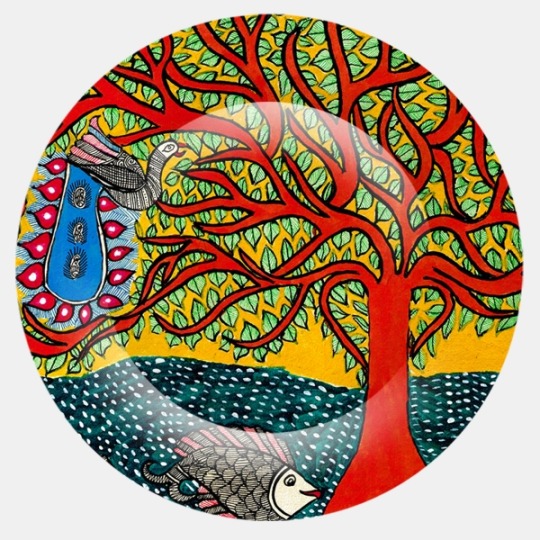
MADHUBANI PAINTINGS: THE MAGICAL WORLD OF STORYTELLING
India is a plethora of rich cultural heritage and traditional art and craft. From every nook and cranny of this vast country, art seems to be oozing in abundance. The influence of various kingdoms and empires can be invariably seen in its varied art forms. One of the most popular among them is Madhubani paintings that originated in the Mithila region of Bihar as wall paintings. Owing to their origin Madhubani paintings are also famously known as Mithila art.
The first mention of the art form is believed to come from the time of Ramayana when King Janak, father of Goddess Sita, ordered the artisans to decorate the walls of the kingdom with this beautiful artwork for the wedding of his daughter with Lord Ram. During ancient times, the walls of the houses in the Madhubani area were decorated with fascinating designs from Madhubani art as a symbol of peace and prosperity.
Earlier confined to the local region of Madhubani, these paintings were exposed to the outside world in 1934. After massive destruction due to the earthquake in the Mithila region in 1934, a British officer, William G. Archer visited Madhubani district and while inspecting the damage caused, he discovered some magnificent paintings on the walls of the houses of the region. He took some pictures of these paintings and mentioned Mithila art in an international art magazine.
Madhubani or Mithila paintings are done using fingers, twigs, matchsticks, brushes, and even pen nibs. The paintings on the walls are known as Bhitti Chitra while the ones on the floor are known as Aripana. The outline for these paintings is done using rice paste and then colours are filled inside the framework. To give a better texture to the walls, a paste of cow dung and mud is used. One would not find any blank spaces left in these paintings. The spaces were filled artistically with geometrical and floral patterns, figures of animals, and birds. Natural colours are used extensively in these paintings. The juice of Kusum flower is often used for pink, indigo for blue, turmeric extract for yellow, sandalwood for red, tesu flowers from Palash tree for orange, charcoal, and soot for black and so on.
Madhubani paintings mostly depict nature and Hindu devotional events, and their themes generally revolve around Hindu deities like Krishna, Ram, Sita, Shiva, Durga, Lakshmi, and Saraswati. Nature and its forms like the sun, moon, and religious plants like tulsi are also commonly painted, along with the scenes from the royal courts and social events like weddings, religious rituals, festival celebrations, etc.
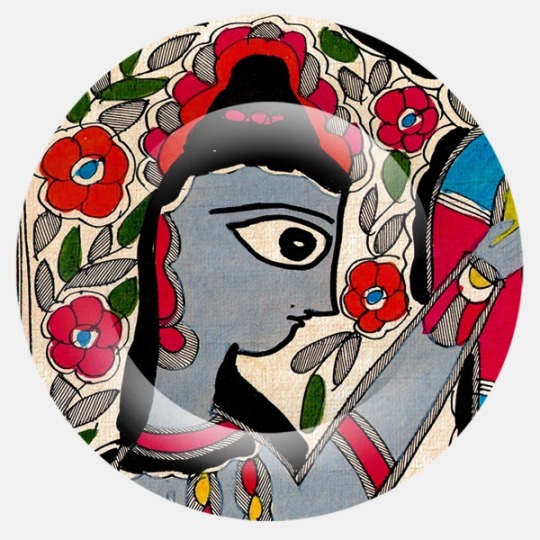


TYPES OF MADHUBANI PAINTINGS
Madhubani paintings are classified under three categories, namely:
BRAHMIN STYLE
The main subject of these paintings were the stories from Hindu mythology that depicted Hindu deities such as Ram, Sita, Krishna, Durga, Kali, and Vishnu among others. These paintings found the extensive use of vibrant colours.
KAYASTHA STYLE
This special form of Madhubani art depicts the characteristics such as fertility, procreation, and life. These types of Madhubani Paintings can be seen on the wall art of Kohbar Ghar (The Nuptial Chamber). The artists generally used a single colour for this form of paintings.
TATOO STYLE
The tatoo form of Madhubani paintings was conceived by the lower caste group of the society. The theme of this style was majorly Moon, Sun, Rahu, flora and fauna of the area, and stories from the lives of the local heroes.
Gradually, the Madhubani painting of India due to the efforts of award-winning artists like Jagdamba Devi, Sita Devi, Godavari Dutta, Mahasundari Devi, etc. found acceptance among the connoisseurs of art at both national and international level. Today, Madhubani art is exported to different countries like the USA, Australia, UK, and Russia. Today, these paintings are not confined to the walls or floors of the houses but patterns from this art form are made on various items like bags, cushion covers, coasters, trays, mugs, crockery, and even wall clocks. Madhubani art is also used to design textile products like saris, stoles, dupattas, shirts, tops, and salwar suits.
Madhubani or Mithila painting has been given the much acclaimed Geographical Indication (G.I.) status in the year 2007. Having been passed from one generation to the other, the content, style, and flavour of these regional Madhubani or Mithila paintings still remain intact and preserved.
Indian handicrafts online
#Madhubani paintings#mithila art#bhitti chitra#aripana#brahmin style#kayastha style#tatoo style#gi tags
1 note
·
View note
Text
The Effervescent Nirmal Toys
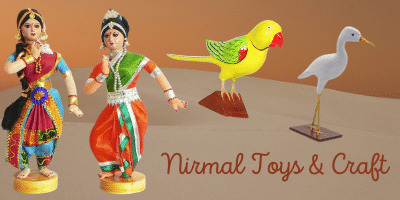
Pride of Telangana
Who doesn’t like toys? These attractive and beautiful articles of play amuse children and adults alike. The art of toy making can be seen in every corner of our country aptly making it a land of toys. The tradition of narrating stories through handmade dolls or ‘kathputlis’ is still prevalent in most parts of the country. Often stories from our epics were connoted through the means of toys.
Nirmal traditional toys and paintings hold a special place in the handicrafts of Telangana. Nirmal district in Adilabad district in Telangana was once famous as a production centre of cannons and toys. The foundries established here supplied ammunition to the army of the Nizam of Hyderabad. It is believed that Nirmal art was brought here by the Naqqash families of Rajasthan who migrated here during 17th century. Nirmal art is the art of making exquisite wooden toys and paintings.
The style of Nirmal toys and craft is a striking amalgamation of Indian and Mughal art – the floral designs and murals from Ajanta and Ellora combined with the Mughal miniature art. These toys are produced from the locally available softwood called poniki or white sander. A mixture of sawdust in tamarind seed paste, called Chinta Lappam, is used as a base to smoothen and give shape to the toy. When dried, the toys are painted with an herbal extract that gives a golden shine to them. Besides the Duco paints, oil paints and enamel colours are used for colouring these toys.
These Nirmal toys are made by the Nakkash artisans in bulk. The quantity of these toys that each artisan prepares depends on the size of the toys that are being manufactured. Then the wood is cut and brought into the desired shape and colours are added. The Nirmal artisans often recreated different personalities through their art from epics, narratives, folklore, and stories that were widely accepted by the kings, royalties, and the common people alike. Initially, figurines based on Indian mythology and motifs inspired by Mughal culture were the major theme of Nirmal toys and craft. Later, with changing times, Nirmal toys saw a major transition, and utility items, furniture, and home decors came under the purview of this art. Nirmal handicrafts typically include toys, plaques, furniture, jewellery, paintings, etc. Often considered to be ideal gifts and souvenirs, Nirmal toys and craft ware occupy a special place in the world of Indian traditional handicrafts. The successful journey of Nirmal artisans over decades shows that even in the present age where modernization has taken over completely, there still remains many connoisseurs of art who believe in patronizing and promoting our traditional art forms. Traditional handicrafts like Nirmal art have given a unique identity and a sense of pride to the small villages from where they originate. Wooden handicrafts are always considered an ideal means of decoration for homes and offices.
Of late, Nirmal artisans have received many awards and showcased their craft at several prestigious venues and exhibitions both in India and abroad. To meet the changing demands and to survive in the modern competitive world where plastic has massively taken over the entire range of traditional wooden toys and craft, these artisans have diversified their ancient art with a new range of artifacts like wooden boxes, key chains, handcrafted jewellery items, divine idols, table lamps, and other decorative items. The wide range of colours and craftsmanship makes these toys an absolute delight.
With the view of patronizing Nirmal art and artisans and sustaining this art form, the artists in this town together created an artisans' co-operative society, The Nirmal Toys Industrial Cooperative Society in the year 1955. Nirmal toys and art received the Geographical Indication Tag in 2009. These toys are easily available in Government Handicraft stores like Lepakshi and Cauvery.
Indian handicrafts online
0 notes
Text
Of artisans and their art
CHALLENGES FACED BY ARTISANS
Indian handicrafts need no introduction anywhere in the world. But with the advent of industrialization and modernization, our traditional Indian handicraft has suffered a major blow. The art has been ignored and the artisans misused. The rural artisans who had received noble patronage during pre-Independence days with their hard work, dedication, and skill were known to create magic on their pieces of artwork. A lack of well-developed policies and programs has resulted in the decline of our handicraft industry.
There are a number of challenges faced by our otherwise talented artisans that prevent them from producing quality handicraft products.
LOW EDUCATION
Most of the craftsmen engage their entire household in the production since this is a seasonal source of income. This results in children neglecting their schools and colleges, thereby leading to low/no education at all. This leaves them ignorant about several government schemes and market information. And they end up being misused by the traders and middlemen.
OBSOLETE PRODUCTION TECHNIQUES
The lack of education and information results in using age-old production methods. The artisans mostly are unaware of the modern ways with which they could enhance their craft. This leads to a high cost of production. Most of them are unable to bear such high costs leading to a compromise in the quality of their work.
LOW PAY AND LACK OF EXPOSURE
Most of the artisans are unaware of their worth and are employed by people who pay them much lesser for their work. These artisans just come and do their work without knowing the actual value of their craftsmanship. Most of them are exploited by their employers who otherwise sell these masterpieces at much higher prices in the market.
LACK OF GOOD QUALITY RAW MATERIAL
The advent of industrialization has resulted in most of the good quality raw materials being purchased by the fast-paced industries. And this leaves the rural artisans with no choice but to buy substandard raw materials. And this greatly impacted the quality of their work.
LACK OF FUNDS
The artisans suffer from major neglect from the central and state government. The lack of working capital and access to bank loan facilities, improper utilization of funds, and lack of marketing facilities for finished products forces the artisans to borrow money from their local moneylenders or traders at a very high rate of interest.
ABSENCE OF ARTISAN-CONSUMER RELATIONSHIP
In the earlier days, there used to be direct interaction between the artisans and the consumers. The artisans were able to produce the masterpieces according to the tastes and likes of their consumers, thereby resulting in product satisfaction for both producers and consumers. Most of the artisans are not aware of whom and how to approach the consumers today.
LACK OF INTEREST BY THE GENERATION-NEXT OF ARTISANS
The new generation of artisans is not interested in continuing the family legacy. This is majorly due to the lack of money, recognition, and social stigma attached to the field today. Instead of taking their tradition further, they are more interested in pursuing a completely different and otherwise promising career. As a result, the evergreen handicrafts industry of our country is suffering a major setback.
Indian handicrafts online
0 notes
Text
Crafts of India

INDIAN HANDICRAFTS: KNOW ABOUT VARIOUS CRAFTS OF INDIA
From time immemorial, the crafts of India are known and praised worldwide. India has a vast cultural heritage that is reflected within the sophistication of its varied craftworks. The skilled artisans have managed to survive and uphold our heritage by creating exclusive pieces of art that reflects the influence of various empires on the works from our different states.
POTTERY
Known as one of the oldest and most beautiful forms of decoration, the tradition of pottery making dates back to the times of Indus Valley Civilization. Decorated pots have been used in all walks for a multitude of purposes. Pottery can be both handmade and wheel-made.
Figurines of religious importance, various artefacts, toys, dolls, pots, vases made of terracotta from Assam, Odisha, Keonjhar and Khurda; painted black wares from Uttar Pradesh; painted pottery with geometrical patterns from Bikaner and Pokhran in Rajasthan and Kagzi pottery from Alwar; the most famous blue pottery (wherein the blue dye is used to colour objects) from Jaipur and works from states of Tamil Nadu, Himachal Pradesh and West Bengal are some of the worth mentioning names.
JUTE
Widely known as the golden fibre, Jute comes second to cotton in terms of production in India. An extremely flexible fibre, it is turned and twisted easily to make a variety of articles. For centuries, jute has been an integral part of the culture of West Bengal, Assam and Bihar.
LEATHER
The leathercraft started perhaps during the times of Indus Valley civilization where the artisans mainly engaged in the making of clothes, footwear, caps, bags, saddles, shield, etc. The leather shoes, bags, garments, etc from Madhya Pradesh and the famous Kolhapuri chappals from Maharashtra are known all across the world.
METAL CRAFT
Metal crafts in India also originated during the Indus Valley Civilization. The statue of the Dancing Girl, bronze statues of the Chola kingdom and the iron pillar erected by Ashoka’s, the great, all witness our rich legacy in metal craft. Besides creating mythological figures and deities, other items include metal pots, pans, frames, locks, key chains etc.
The famous metal craft includes Bidri ware of Andhra Pradesh; Pembharti from Warangal district in Telangana; Dhokra metal craft from Andhra Pradesh, Odisha and Madhya Pradesh; Kamrupi metal craft from Kamrup, Assam. Made from brass and bell metal the items produced by this metal craft are pots, bowls, water pots, cymbals etc. The region of Ladakh is famous for its brass and iron vessels and the Kashmir is known for its naquashi work.
STONEWORK
Stonework has always fascinated all since long. The intricately carved palaces, forts and temples where various forms of carving, engraving, sculptures and undercuts are done on stones. The rock and marble carvings from Rajasthan, Jaipur, Odisha and Nagpur; the stoneware from Madhya Pradesh includes household items such as chakla, silbatta, handis, chakkis, etc. Gwalior, Ratlam, Mandsaur are famous for sculptures and figurines of religious importance. Pattharkatti in Gaya, Bihar is known as the village of stone carvers where the artisans churn out beautiful pieces made from black stone (granite). The ancient temples of Odisha and Khajuraho are world-famous examples of rock crafts of India. Marble ware from Agra in Uttar Pradesh owes its credit to the famous Taj Mahal.
NEEDLEWORK
The rich craft of India is incomplete without the mention of the famous thread and needlework from the different states of our sub-continent. The chikankari from Lucknow, crewel embroidery from Kashmir, applique work from Rajasthan, mirror embroidery from Gujarat and Rajasthan, kantha embroidery from West Bengal, phulkari from Punjab, Zardozi from Uttar Pradesh. Today these works are not limited to clothes but shawls, pillow and cushion covers, dupattas, home furnishings, bags, bedspreads, wall hangings are all in high demand.
WEAVE CRAFT
India has a rich and diverse weaving tradition. Be it fabrics made out of silk, cotton, or wool, the demand is never-ending. Silk saris, namely the Baluchari of West Bengal and Mooga and Assam silk of Assam, famous Banarasi saris, Kanchipuram, and Pochampalli saris from Tamil Nadu, Paithani from Maharashtra are among the finest saris in India. Among the cotton work, Khadi and kalamkari continue to dominate the market even today. Wool work is best when it comes to Pashmina shawls from Kashmir and Kullu shawls from Himachal Pradesh.
GI location crafts in India
The Indian traditional crafts have been diminishing in the current times. In order to protect our precious craftworks and the associated cultural heritage, GI tag is conferred on the handicrafts. The tag is used on products which corresponds to a specific geographical location from where they originated. The Government of India enforced the Geographical Indications of Goods (Registration and Protection) Act in 1999, which came into force in 2003. The GI tag confirms the product is made with specific standards and provide proprietary rights to the traditional producers and encourage them to make and sell authentic products. Today more than 150 handicraft products have been added to the GI list. The most popular ones include:
Geographical Indication State/UT
Pochampalli Ikat Telangana
Chanderi Saris Madhya Pradesh
Mysore Silk Karnataka
Bidriware Karnataka
Kullu shawl Himachal Pradesh
Channapatna toys and dolls Karnataka
Phulkari Punjab, Haryana & Rajasthan
Kashmir Pashmina Kashmir
Thanjavur paintings Tamil Nadu
Kani shawl Jammu & Kashmir
Nakshi Kantha West Bengal
Blue pottery of Jaipur Rajasthan
Bastar Dhokra Chattisgarh
Kutch embroidery Gujarat
Lucknowi Chikankari Uttar Pradesh
Sanganeri hand block print Rajasthan
Kota Doria Rajasthan
Warli painting Maharashtra
Kolhapuri chappal Maharashtra
Temple jewelry of Nagercoil Tamil Nadu
Durgi stone carvings Andhra Pradesh
Orissa Pattachitra Odisha
Patola Sari Gujarat
Banaras brocades and saris Uttar Pradesh
Lucknowi Zardozi Uttar Pradesh
Bobbili Veena Andhra Pradesh
Kashmir paper machie Jammu & Kashmir
Toda embroidery Tamil Nadu
Leather toys of Indore Madhya Pradesh
Nirmal toys and craft Telangana
Salem silk Tamil Nadu
Sikki grass products of Bihar Bihar
Khatwa work of Bihar (Applique) Bihar
Indian handicrafts online
4 notes
·
View notes
Text
Bell Metal Craft of West Bengal
DHOKRA (DOKRA) ART OF TRIBES
Reflecting the simplicity of tribal and folklife, Dhokra or Dokra art is an ancient method of making metal artefacts from the state of West Bengal. Also known as bell metal craft, Dhokra art originated perhaps 5000 years with the Dancing Girl from Mohenjo-Daro being the earliest known masterpiece of this tribal art form.
The art form gets its name from the Dhokra/Dokra Damar tribes of West Bengal who were basically metalsmiths. Later, the tribes moved to Jharkhand, Orissa and Chhattisgarh.
THE METHOD BEHIND THE INDIGENOUS ART FORM
Dhokra craft objects are created through the method of non-ferrous metal casting using the lost-wax casting technique. A hollow casting is used for making a clay core that would define the model of the object to be created. The core is further filled with wax and resin. This wax is then shaped and finer details are made with proper embellishments. It is then covered with clay and several holes are made on the mould so that the wax can be drained after the mould is heated. The molten metal is then added to the mould and it drains out the wax from the holes. The metal is then left for hardening inside the mould. When the metal finally cools down and gets dried, the clay mould is broken off and the desired artefact is obtained. Since the mould is used only once and broken, the figure obtained is one of its kind in the handicraft market. Finally, it is polished and the final artefact gets ready.
Dhokra art is usually depicted in human and animal figures symbolising a various form of tribal life, religious deities, home decoration items, lamps. The traditional Dokra jewellery also manages to attract a large number of the population both in India and abroad. Dhokra requires are high labour work because even a simple piece requires 4-5 days to get prepared which might extend to a few weeks depending on the complexity of the design.
MAINTENANCE OF DHOKRA ARTEFACTS
It is easy to acquire any exclusive piece of art but what is difficult is the maintenance of these things. A little care can help maintain the original sheen and look of most of the Dokra items. All you need to do is regularly dust the artefacts with a clean, soft and non-fibrous cloth. As for the gaps and clefts, a soft toothbrush or a paintbrush can be used. However, due to the exposure to the atmospheric moisture, a greenish-brown patina is formed on their surfaces, which is absolutely normal for these articles. For shine freaks, simply wipe the article with a brass polish or lemon juice mixed with soda bicarbonate, taken on a soft cloth. Thereafter make sure that it is wiped off with a dry cloth. Water should not be used at any cost. Jewellery pieces can be wrapped in a soft cotton cloth or a tissue paper and kept in a closed box.
FUTURE OF DHOKRA ART: REVIVING THE AGE-OLD TRADITIONAL ART
This beautiful art form, like most others, is facing a decline in the market today. The increase in the cost of raw material like brass and bronze has made these objets d’art extremely expensive. Also, massive deforestation has affected the supply of other raw materials like wax, soil etc. As a result, the market does not pay these artisans well. Hence the new generation is showing less interest in producing such masterpieces. With proper inspiration, encouragement and knowledge of new and modern designs given to the artisans this otherwise diminishing art form can be revived and resurrected.
Indian handicrafts online
0 notes